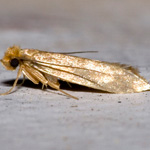Moth biology
Closely related to butterflies, moths belong to the order of Lepidoptera. Most moth species are nocturnal. Whilst most are outdoor species, some enter the home were they can present problems and damage woolen fabric (larvae of clothes moth) and others can contamination food sources (house moths, indian meal moth and flour moth). The caterpillars of these moth species are responsible for damage as the adult moths feed on pollen and nectar. Moths are often introduced in the home via birds nest.
Common clothes moth (Tineola bisselliella)

Common Clothes Moth
The adult moth is a metallic beige color and about 8mm in length. The adult moth usually enters buildings from open windows and doors or the infestation might originate from birds nests. The female moth dies after laying about 50 eggs over the period of several weeks. The larvae emerge after a week, but development into an adult can take from 1 month to several years. The larvae feed continuously from woolen fabrics in a enclosed tunnel system, severely damaging woolen fabrics in the process.
Methods of moth control
It is important that all woolen fabrics are protected in sealed bags. Insecticides allowed for the elimination of clothes moths include (cy)fluthrin (a residual synthetic pyrethroid insecticide) impregnated paper strips, or ULV fumigation to eliminate moths on the wing (only recommended as part of an integrated pest management program).
In the past it was common to add 1,4-dichlorobenzene or naphthalene derivatives (moth balls) crystals to lockable wardrobes. However this practice is now banned, as these components are classed as suspected carcinogens (cancer causing agents). Moth-balls are also acutely toxic when ingested, and the sale (and use by pest control professionals) of moth balls containing the components mentioned previously is now prohibited in the UK.
Rooms / carpets were moths were present need vacuuming. Fabrics need dry cleaning before storage in air tight bags as clothes cannot be treated with insecticides. Carpets, cracks and crevices in wardrobes and around rooms are treated with a residual insecticide. In addition we usually place pheromone lures after treatment for monitoring purposes, and it might be necessary to re-treat if moths are found in lures to ensure a moth-free environment.
